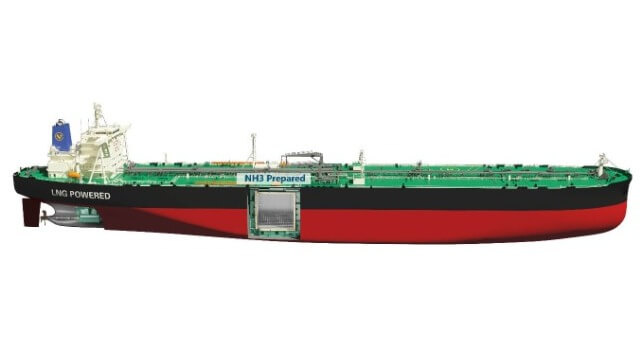Breakthrough Design of LNG-Fueled/Ammonia Ready VLCC Receives Approval

A collaboration between a shipbuilder, shipowner, tank designer, and class society is reporting a significant breakthrough in the development of designs for the next step in ammonia-ready VLCCs that will support the adoption of zero-emission shipping. French class society Bureau Veritas participated in the project and awarded an Approval in Principle (AIP) for the LNG dual-fueled and ammonia fuel prepared very large crude carrier (VLCC).
“The joint project has successfully developed an LNG Dual Fueled and Ammonia Prepared VLCC with membrane type storage tank as LNG fuel tank and ammonia prepared by integrating resources of the shipyard, energy industry, ship owner, core equipment suppliers, and classification society,” said Wei Zheng, Technical Director, Vice President of Dalian Shipbuilding Industry Co. (DSIC). “We look forward to strengthening communication and complementary advantages with TotalEnergies, China Merchant Energy Shipping, GTT, and BV to achieve outstanding accomplishment.”
The next generation of VLCC is powered by LNG and features an integrated GTT Mark III membrane containment technology. Engineers and designers were successful in relocating the fuel tank under the main deck to avoid weather exposure, a piracy risk, and at the same time lower the propulsion systems’ center of gravity.
Current designs for LNG vessels do not permit the tanks to be converted to future use with ammonia raising the cost and reducing the practicality of the conversion. In a separate report also released today the not-for-profit, independent research Mærsk Mc-Kinney Møller Center for Zero Carbon Shipping highlights the considerations and benefits of preparing vessels for future conversion to reduce costs and increase the feasibility of adapting to alternative fuels.
The project for the VLCC design included participation from China Merchants Energy Shipping Co., TotalEnergies, and GTT as the developer of the tank system. They are highlighting that the storage tank is compatible with liquid ammonia fuel, giving the owner and charterer greater operational flexibility. As ammonia is heavier than LNG, the structure of the tank has also been strengthened to support the anticipated loads.
The companies are highlighting the flexibility of the design and the anticipated operational efficiency of the vessel. The tank capacity of this new VLCC ranges from 9,000 to 14,000 cubic meters. As a result, they report the minimum endurance for the vessel with LNG fuel is 23,000 nautical miles and 17,000 nautical miles for ammonia.
“We are very proud to have developed this new generation of LNG and NH3 fuelled VLCCs thanks to the expertise of the market’s key players,” said Adnan Ezzarhouni, General Manager of GTT. “This concept of multi-fuel VLCC with enhanced endurance not only enables safer and more efficient operations but also offers greater bunkering flexibility for ship owners and charterers towards a carbon-free future.”
In addition to its operational benefits, the new LNG-fueled and ammonia-ready VLCC concept complies with key environmental requirements. Its Energy Efficiency Design Index (EEDI) is more than 40 percent under the baseline, its Nitrogen Oxides (NOX) emissions meet the IMO’s Tier III requirements, and its Carbon Intensity Index (CII) is projected to be rated A by 2030.
